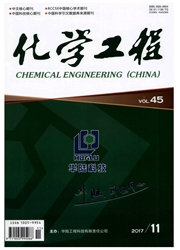

 中文摘要:
中文摘要:
为了揭示分离空间结构对水力喷射空气旋流器(WSA)的气液传质性能影响作用机理,采用雷诺应力模型(RSM)和流体体积多相流(VOF)模型对圆柱型和柱锥结合型水力喷射空气旋流器内部耦合场进行了数值模拟,并以CO2-NaOH化学吸收体系测定了这2种分离空间结构WSA的有效比相界面积。结果表明:分离空间结构对WSA内的射-旋流耦合场中轴向、切向和径向速度分布都有较大影响。柱锥结合型WSA的耦合场具有较高的切向速度、较低的轴向速度和较稳定的径向速度;而圆柱型WSA的耦合场具有较大的轴向速度、较小的切向速度和稳定性较小的径向速度场。与圆柱型WSA相比,柱锥结合型WSA的流体湍动能和有效比相界面积高于前者,这是后者传质效率高的主要原因。
 英文摘要:
英文摘要:
In order to reveal the mechanism, the coupling fields formed by the jet field with rotating gas field in two kinds of WSA with a cylindrical and a conical separation space configuration was simulated using computational fluid dynamics (CFD) method. Moreover, effective gas-liquid interracial area per unit volume (a) of the two WSA was also determined by chemical reaction method with CO2-NaOH solution system. The results indicate that the separation space configuration has a greater effect on the velocities of three dimensional spaces in the coupling field. The coupling field in the WSA with a conical structure has a higher tangential velocity, lower axial velocity and more steady radial velocity, whereas the coupling field in the WSA with a cylindrical structure has a lower tangential velocity, greater axial velocity and unsteady radial velocity. Compared with the WSA with a cylindrical structure, the WSA with a conical structure also exhibits better mass transfer performance because of the larger value of a and turbulent kinetic energy of the flow.
 同期刊论文项目
同期刊论文项目
 同项目期刊论文
同项目期刊论文
 期刊信息
期刊信息
